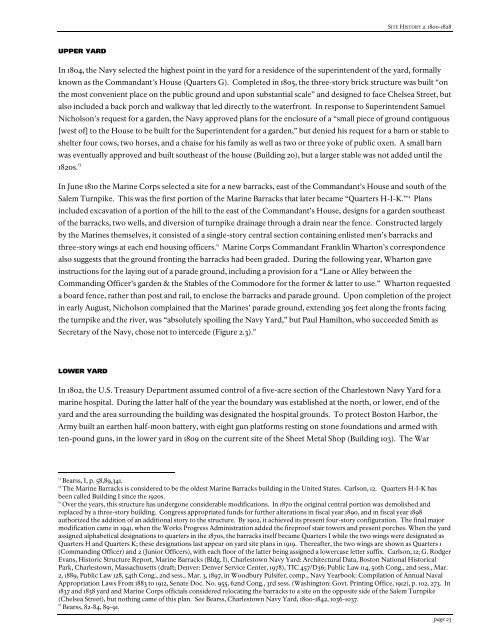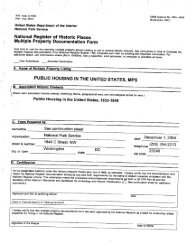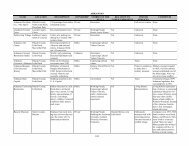Cultural Landscape Report for Charlestown Navy Yard, Boston
Cultural Landscape Report for Charlestown Navy Yard, Boston
Cultural Landscape Report for Charlestown Navy Yard, Boston
Create successful ePaper yourself
Turn your PDF publications into a flip-book with our unique Google optimized e-Paper software.
UPPER YARD<br />
SITE HISTORY 2. 1800-1828<br />
In 1804, the <strong>Navy</strong> selected the highest point in the yard <strong>for</strong> a residence of the superintendent of the yard, <strong>for</strong>mally<br />
known as the Commandant's House (Quarters G). Completed in 1805, the three-story brick structure was built “on<br />
the most convenient place on the public ground and upon substantial scale” and designed to face Chelsea Street, but<br />
also included a back porch and walkway that led directly to the waterfront. In response to Superintendent Samuel<br />
Nicholson’s request <strong>for</strong> a garden, the <strong>Navy</strong> approved plans <strong>for</strong> the enclosure of a “small piece of ground contiguous<br />
[west of] to the House to be built <strong>for</strong> the Superintendent <strong>for</strong> a garden,” but denied his request <strong>for</strong> a barn or stable to<br />
shelter four cows, two horses, and a chaise <strong>for</strong> his family as well as two or three yoke of public oxen. A small barn<br />
was eventually approved and built southeast of the house (Building 20), but a larger stable was not added until the<br />
1820s. 13<br />
In June 1810 the Marine Corps selected a site <strong>for</strong> a new barracks, east of the Commandant’s House and south of the<br />
Salem Turnpike. This was the first portion of the Marine Barracks that later became “Quarters H-I-K.” 14 Plans<br />
included excavation of a portion of the hill to the east of the Commandant’s House, designs <strong>for</strong> a garden southeast<br />
of the barracks, two wells, and diversion of turnpike drainage through a drain near the fence. Constructed largely<br />
by the Marines themselves, it consisted of a single-story central section containing enlisted men’s barracks and<br />
three-story wings at each end housing officers. 15 Marine Corps Commandant Franklin Wharton’s correspondence<br />
also suggests that the ground fronting the barracks had been graded. During the following year, Wharton gave<br />
instructions <strong>for</strong> the laying out of a parade ground, including a provision <strong>for</strong> a “Lane or Alley between the<br />
Commanding Officer’s garden & the Stables of the Commodore <strong>for</strong> the <strong>for</strong>mer & latter to use.” Wharton requested<br />
a board fence, rather than post and rail, to enclose the barracks and parade ground. Upon completion of the project<br />
in early August, Nicholson complained that the Marines’ parade ground, extending 305 feet along the fronts facing<br />
the turnpike and the river, was “absolutely spoiling the <strong>Navy</strong> <strong>Yard</strong>,” but Paul Hamilton, who succeeded Smith as<br />
Secretary of the <strong>Navy</strong>, chose not to intercede (Figure 2.3). 16<br />
LOWER YARD<br />
In 1802, the U.S. Treasury Department assumed control of a five-acre section of the <strong>Charlestown</strong> <strong>Navy</strong> <strong>Yard</strong> <strong>for</strong> a<br />
marine hospital. During the latter half of the year the boundary was established at the north, or lower, end of the<br />
yard and the area surrounding the building was designated the hospital grounds. To protect <strong>Boston</strong> Harbor, the<br />
Army built an earthen half-moon battery, with eight gun plat<strong>for</strong>ms resting on stone foundations and armed with<br />
ten-pound guns, in the lower yard in 1809 on the current site of the Sheet Metal Shop (Building 103). The War<br />
13<br />
Bearss, I, p. 58,89,341.<br />
14<br />
The Marine Barracks is considered to be the oldest Marine Barracks building in the United States. Carlson, 12. Quarters H-I-K has<br />
been called Building I since the 1920s.<br />
15<br />
Over the years, this structure has undergone considerable modifications. In 1870 the original central portion was demolished and<br />
replaced by a three-story building. Congress appropriated funds <strong>for</strong> further alterations in fiscal year 1890, and in fiscal year 1898<br />
authorized the addition of an additional story to the structure. By 1902, it achieved its present four-story configuration. The final major<br />
modification came in 1941, when the Works Progress Administration added the fireproof stair towers and present porches. When the yard<br />
assigned alphabetical designations to quarters in the 1870s, the barracks itself became Quarters I while the two wings were designated as<br />
Quarters H and Quarters K; these designations last appear on yard site plans in 1919. Thereafter, the two wings are shown as Quarters 1<br />
(Commanding Officer) and 2 (Junior Officers), with each floor of the latter being assigned a lowercase letter suffix. Carlson, 12; G. Rodger<br />
Evans, Historic Structure <strong>Report</strong>, Marine Barracks (Bldg. I), <strong>Charlestown</strong> <strong>Navy</strong> <strong>Yard</strong>: Architectural Data, <strong>Boston</strong> National Historical<br />
Park, <strong>Charlestown</strong>, Massachusetts (draft; Denver: Denver Service Center, 1978), TIC 457/D36; Public Law 114, 50th Cong., 2nd sess., Mar.<br />
2, 1889, Public Law 128, 54th Cong., 2nd sess., Mar. 3, 1897, in Woodbury Pulsifer, comp., <strong>Navy</strong> Yearbook: Compilation of Annual Naval<br />
Appropriation Laws From 1883 to 1912, Senate Doc. No. 955, 62nd Cong., 3rd sess. (Washington: Govt. Printing Office, 1912), p. 102, 273. In<br />
1837 and 1838 yard and Marine Corps officials considered relocating the barracks to a site on the opposite side of the Salem Turnpike<br />
(Chelsea Street), but nothing came of this plan. See Bearss, <strong>Charlestown</strong> <strong>Navy</strong> <strong>Yard</strong>, 1800-1842, 1036-1037.<br />
16<br />
Bearss, 82-84, 89-91.<br />
page 23







